Total Workplace Safety, Health, and Wellbeing: A Comprehensive Report
VerifiedAdded on 2022/08/21
|11
|2879
|15
Report
AI Summary
This report provides a comprehensive analysis of Total Workplace Health, Safety, and Wellbeing (TWSH), emphasizing the interconnectedness of these elements in fostering a positive work environment and achieving organizational goals. It explores the shift from traditional safety approaches to a holistic TWSH model that prioritizes employee physical and mental health, quality of work-life, and work-life balance. The report highlights the importance of Singapore's focus on TWSH due to its reliance on manpower and knowledge-based economy. It delves into the roles of employers and management in implementing TWSH, including risk assessments, strategy development, and continuous evaluation, with a focus on the construction and manufacturing industries. The report stresses the significance of training, providing necessary safety equipment, and adapting TWSH approaches to enhance productivity and employee wellbeing. It also provides an overview of the key elements that influence the implementation of the TWSH within the organization. The report concludes by emphasizing the need for an interconnected approach to ensure workplace safety, employee wellbeing, and organizational effectiveness.
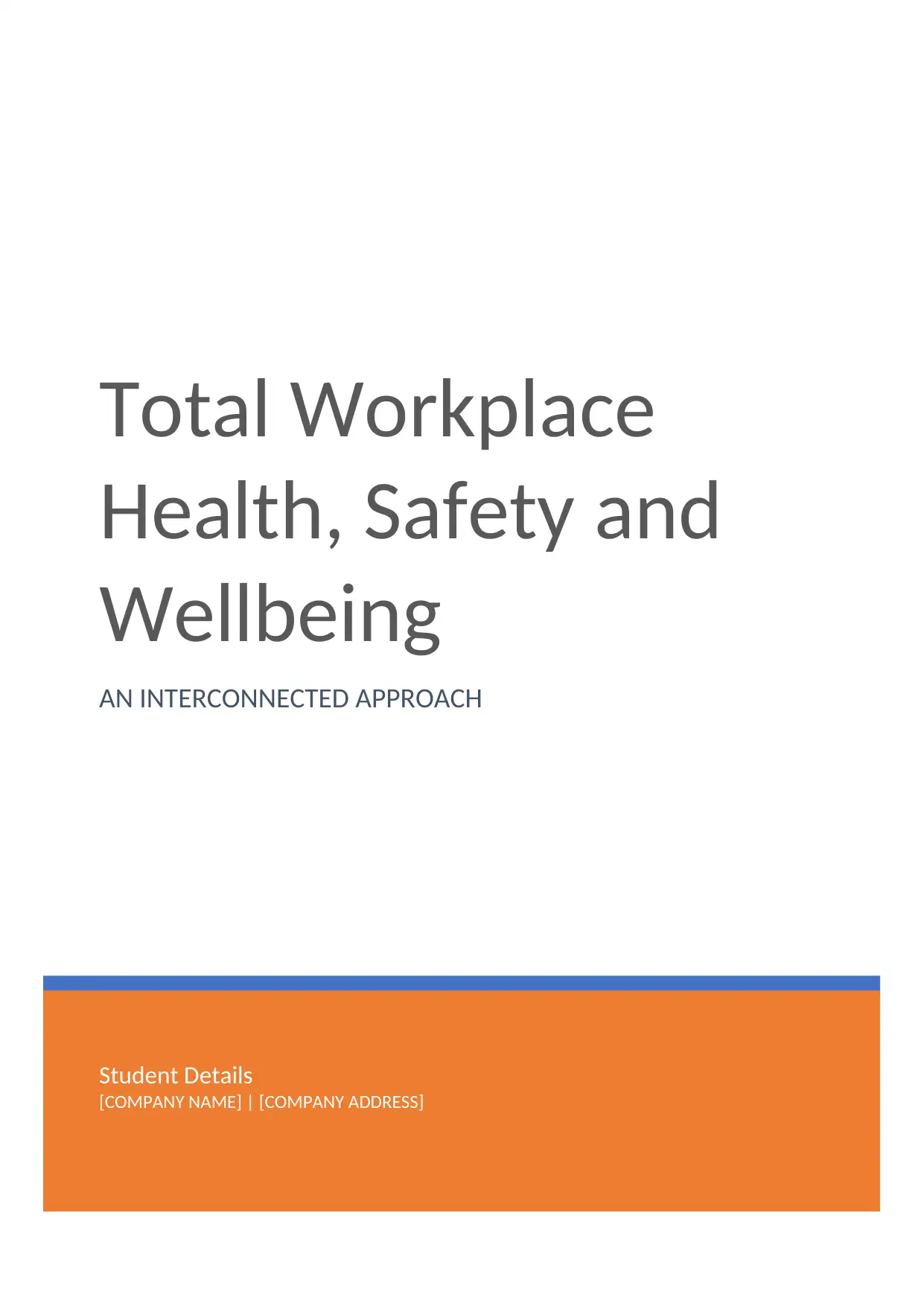
Student Details
[COMPANY NAME] | [COMPANY ADDRESS]
Total Workplace
Health, Safety and
Wellbeing
AN INTERCONNECTED APPROACH
[COMPANY NAME] | [COMPANY ADDRESS]
Total Workplace
Health, Safety and
Wellbeing
AN INTERCONNECTED APPROACH
Paraphrase This Document
Need a fresh take? Get an instant paraphrase of this document with our AI Paraphraser
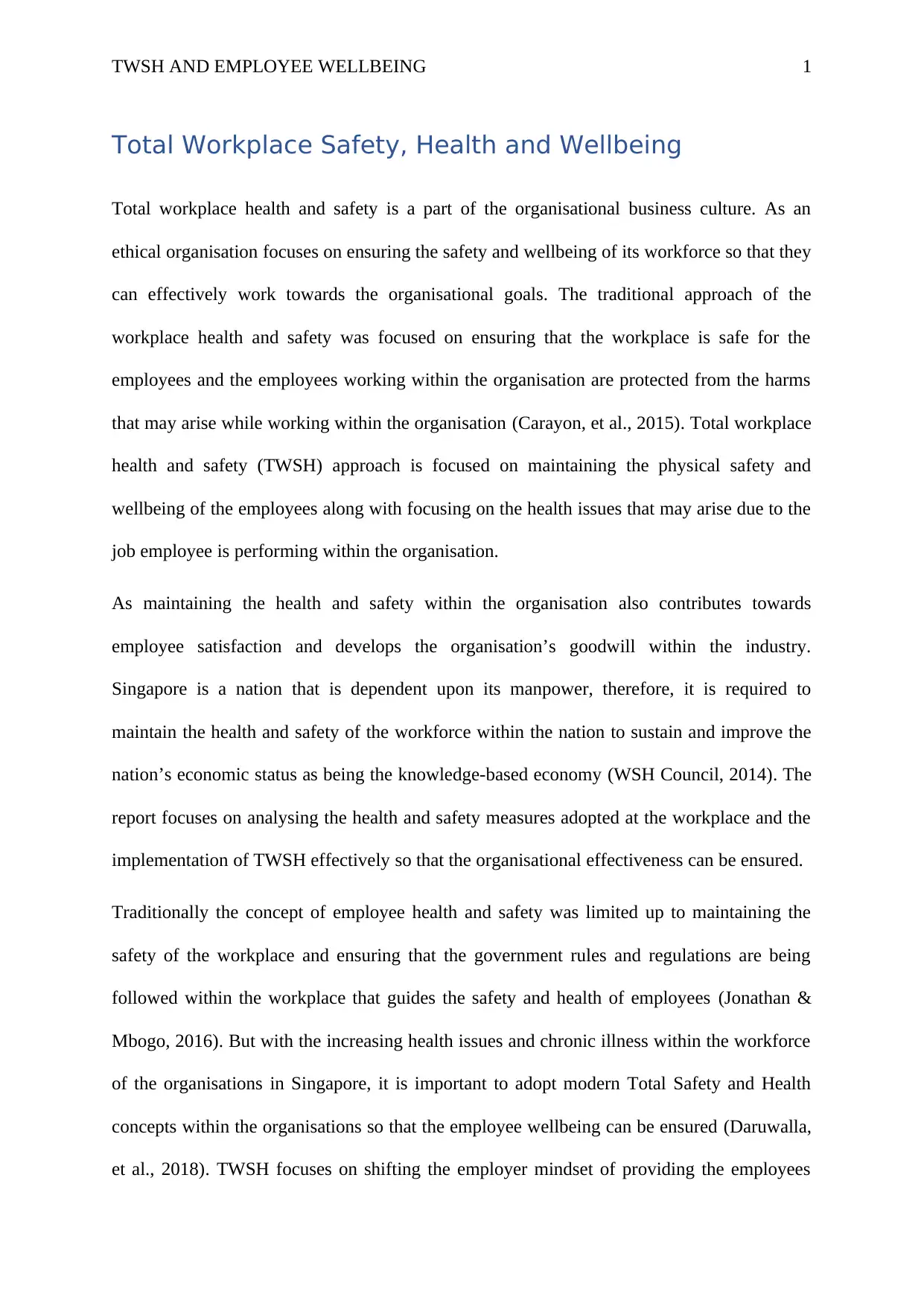
TWSH AND EMPLOYEE WELLBEING 1
Total Workplace Safety, Health and Wellbeing
Total workplace health and safety is a part of the organisational business culture. As an
ethical organisation focuses on ensuring the safety and wellbeing of its workforce so that they
can effectively work towards the organisational goals. The traditional approach of the
workplace health and safety was focused on ensuring that the workplace is safe for the
employees and the employees working within the organisation are protected from the harms
that may arise while working within the organisation (Carayon, et al., 2015). Total workplace
health and safety (TWSH) approach is focused on maintaining the physical safety and
wellbeing of the employees along with focusing on the health issues that may arise due to the
job employee is performing within the organisation.
As maintaining the health and safety within the organisation also contributes towards
employee satisfaction and develops the organisation’s goodwill within the industry.
Singapore is a nation that is dependent upon its manpower, therefore, it is required to
maintain the health and safety of the workforce within the nation to sustain and improve the
nation’s economic status as being the knowledge-based economy (WSH Council, 2014). The
report focuses on analysing the health and safety measures adopted at the workplace and the
implementation of TWSH effectively so that the organisational effectiveness can be ensured.
Traditionally the concept of employee health and safety was limited up to maintaining the
safety of the workplace and ensuring that the government rules and regulations are being
followed within the workplace that guides the safety and health of employees (Jonathan &
Mbogo, 2016). But with the increasing health issues and chronic illness within the workforce
of the organisations in Singapore, it is important to adopt modern Total Safety and Health
concepts within the organisations so that the employee wellbeing can be ensured (Daruwalla,
et al., 2018). TWSH focuses on shifting the employer mindset of providing the employees
Total Workplace Safety, Health and Wellbeing
Total workplace health and safety is a part of the organisational business culture. As an
ethical organisation focuses on ensuring the safety and wellbeing of its workforce so that they
can effectively work towards the organisational goals. The traditional approach of the
workplace health and safety was focused on ensuring that the workplace is safe for the
employees and the employees working within the organisation are protected from the harms
that may arise while working within the organisation (Carayon, et al., 2015). Total workplace
health and safety (TWSH) approach is focused on maintaining the physical safety and
wellbeing of the employees along with focusing on the health issues that may arise due to the
job employee is performing within the organisation.
As maintaining the health and safety within the organisation also contributes towards
employee satisfaction and develops the organisation’s goodwill within the industry.
Singapore is a nation that is dependent upon its manpower, therefore, it is required to
maintain the health and safety of the workforce within the nation to sustain and improve the
nation’s economic status as being the knowledge-based economy (WSH Council, 2014). The
report focuses on analysing the health and safety measures adopted at the workplace and the
implementation of TWSH effectively so that the organisational effectiveness can be ensured.
Traditionally the concept of employee health and safety was limited up to maintaining the
safety of the workplace and ensuring that the government rules and regulations are being
followed within the workplace that guides the safety and health of employees (Jonathan &
Mbogo, 2016). But with the increasing health issues and chronic illness within the workforce
of the organisations in Singapore, it is important to adopt modern Total Safety and Health
concepts within the organisations so that the employee wellbeing can be ensured (Daruwalla,
et al., 2018). TWSH focuses on shifting the employer mindset of providing the employees
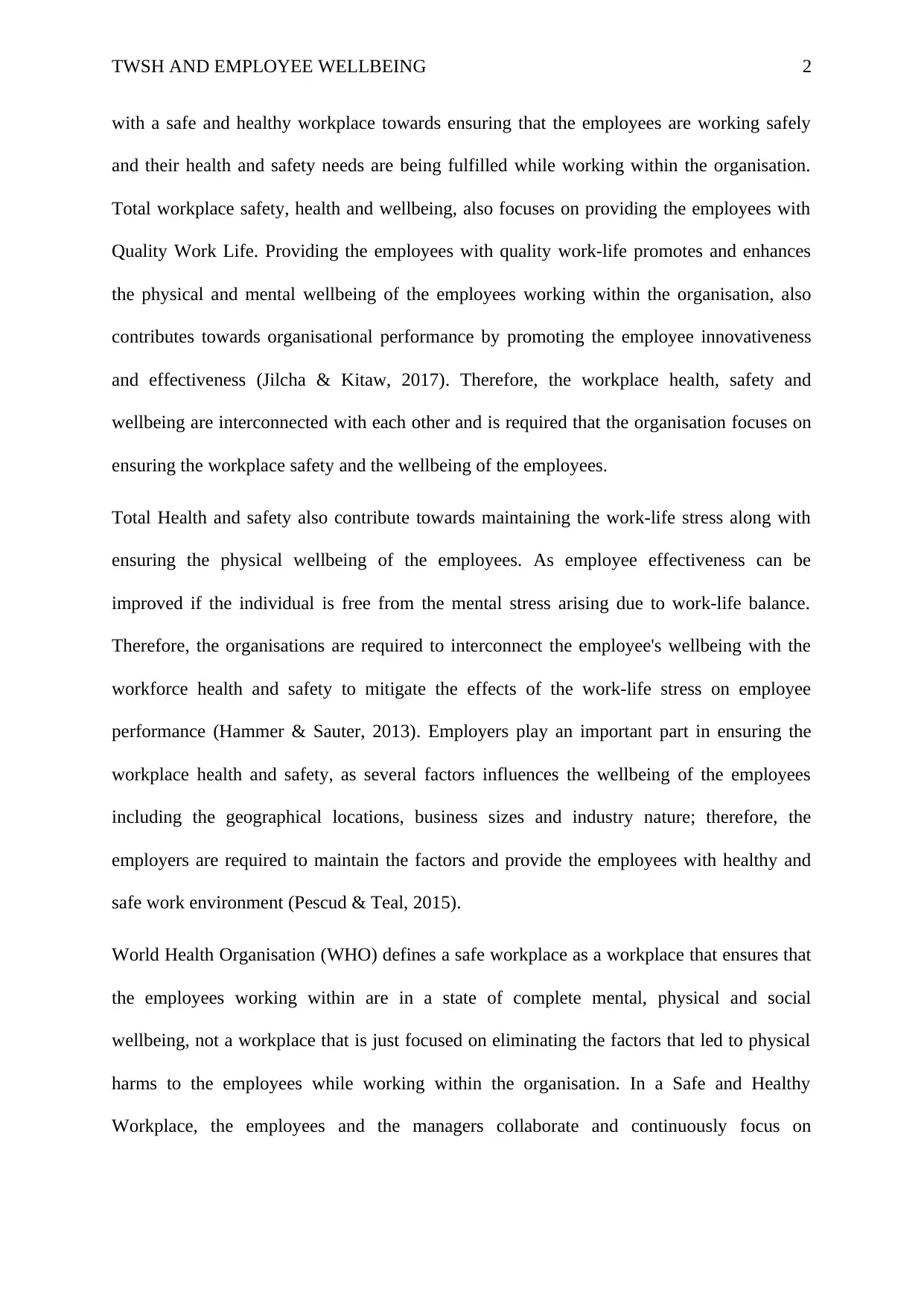
TWSH AND EMPLOYEE WELLBEING 2
with a safe and healthy workplace towards ensuring that the employees are working safely
and their health and safety needs are being fulfilled while working within the organisation.
Total workplace safety, health and wellbeing, also focuses on providing the employees with
Quality Work Life. Providing the employees with quality work-life promotes and enhances
the physical and mental wellbeing of the employees working within the organisation, also
contributes towards organisational performance by promoting the employee innovativeness
and effectiveness (Jilcha & Kitaw, 2017). Therefore, the workplace health, safety and
wellbeing are interconnected with each other and is required that the organisation focuses on
ensuring the workplace safety and the wellbeing of the employees.
Total Health and safety also contribute towards maintaining the work-life stress along with
ensuring the physical wellbeing of the employees. As employee effectiveness can be
improved if the individual is free from the mental stress arising due to work-life balance.
Therefore, the organisations are required to interconnect the employee's wellbeing with the
workforce health and safety to mitigate the effects of the work-life stress on employee
performance (Hammer & Sauter, 2013). Employers play an important part in ensuring the
workplace health and safety, as several factors influences the wellbeing of the employees
including the geographical locations, business sizes and industry nature; therefore, the
employers are required to maintain the factors and provide the employees with healthy and
safe work environment (Pescud & Teal, 2015).
World Health Organisation (WHO) defines a safe workplace as a workplace that ensures that
the employees working within are in a state of complete mental, physical and social
wellbeing, not a workplace that is just focused on eliminating the factors that led to physical
harms to the employees while working within the organisation. In a Safe and Healthy
Workplace, the employees and the managers collaborate and continuously focus on
with a safe and healthy workplace towards ensuring that the employees are working safely
and their health and safety needs are being fulfilled while working within the organisation.
Total workplace safety, health and wellbeing, also focuses on providing the employees with
Quality Work Life. Providing the employees with quality work-life promotes and enhances
the physical and mental wellbeing of the employees working within the organisation, also
contributes towards organisational performance by promoting the employee innovativeness
and effectiveness (Jilcha & Kitaw, 2017). Therefore, the workplace health, safety and
wellbeing are interconnected with each other and is required that the organisation focuses on
ensuring the workplace safety and the wellbeing of the employees.
Total Health and safety also contribute towards maintaining the work-life stress along with
ensuring the physical wellbeing of the employees. As employee effectiveness can be
improved if the individual is free from the mental stress arising due to work-life balance.
Therefore, the organisations are required to interconnect the employee's wellbeing with the
workforce health and safety to mitigate the effects of the work-life stress on employee
performance (Hammer & Sauter, 2013). Employers play an important part in ensuring the
workplace health and safety, as several factors influences the wellbeing of the employees
including the geographical locations, business sizes and industry nature; therefore, the
employers are required to maintain the factors and provide the employees with healthy and
safe work environment (Pescud & Teal, 2015).
World Health Organisation (WHO) defines a safe workplace as a workplace that ensures that
the employees working within are in a state of complete mental, physical and social
wellbeing, not a workplace that is just focused on eliminating the factors that led to physical
harms to the employees while working within the organisation. In a Safe and Healthy
Workplace, the employees and the managers collaborate and continuously focus on
⊘ This is a preview!⊘
Do you want full access?
Subscribe today to unlock all pages.

Trusted by 1+ million students worldwide
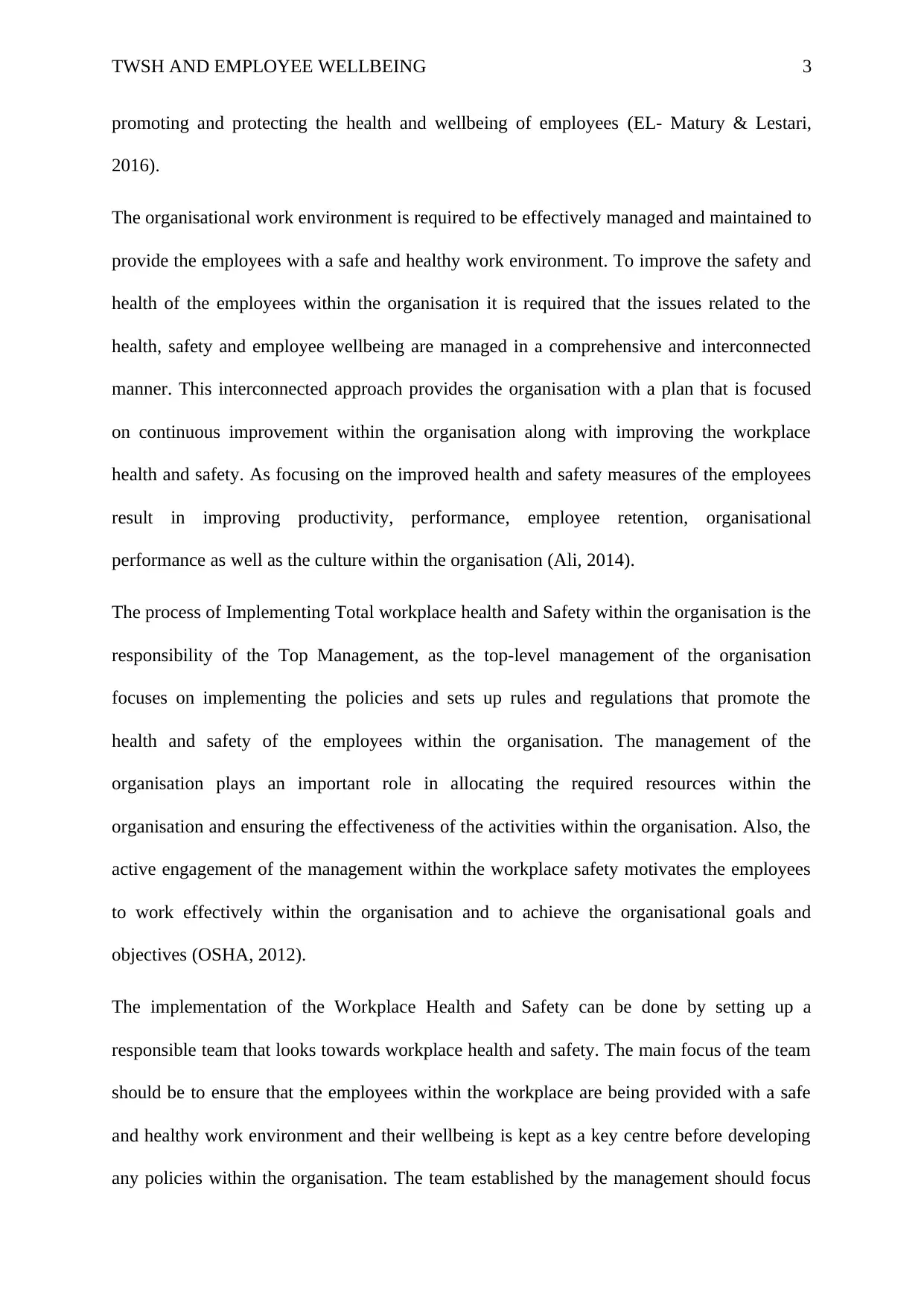
TWSH AND EMPLOYEE WELLBEING 3
promoting and protecting the health and wellbeing of employees (EL- Matury & Lestari,
2016).
The organisational work environment is required to be effectively managed and maintained to
provide the employees with a safe and healthy work environment. To improve the safety and
health of the employees within the organisation it is required that the issues related to the
health, safety and employee wellbeing are managed in a comprehensive and interconnected
manner. This interconnected approach provides the organisation with a plan that is focused
on continuous improvement within the organisation along with improving the workplace
health and safety. As focusing on the improved health and safety measures of the employees
result in improving productivity, performance, employee retention, organisational
performance as well as the culture within the organisation (Ali, 2014).
The process of Implementing Total workplace health and Safety within the organisation is the
responsibility of the Top Management, as the top-level management of the organisation
focuses on implementing the policies and sets up rules and regulations that promote the
health and safety of the employees within the organisation. The management of the
organisation plays an important role in allocating the required resources within the
organisation and ensuring the effectiveness of the activities within the organisation. Also, the
active engagement of the management within the workplace safety motivates the employees
to work effectively within the organisation and to achieve the organisational goals and
objectives (OSHA, 2012).
The implementation of the Workplace Health and Safety can be done by setting up a
responsible team that looks towards workplace health and safety. The main focus of the team
should be to ensure that the employees within the workplace are being provided with a safe
and healthy work environment and their wellbeing is kept as a key centre before developing
any policies within the organisation. The team established by the management should focus
promoting and protecting the health and wellbeing of employees (EL- Matury & Lestari,
2016).
The organisational work environment is required to be effectively managed and maintained to
provide the employees with a safe and healthy work environment. To improve the safety and
health of the employees within the organisation it is required that the issues related to the
health, safety and employee wellbeing are managed in a comprehensive and interconnected
manner. This interconnected approach provides the organisation with a plan that is focused
on continuous improvement within the organisation along with improving the workplace
health and safety. As focusing on the improved health and safety measures of the employees
result in improving productivity, performance, employee retention, organisational
performance as well as the culture within the organisation (Ali, 2014).
The process of Implementing Total workplace health and Safety within the organisation is the
responsibility of the Top Management, as the top-level management of the organisation
focuses on implementing the policies and sets up rules and regulations that promote the
health and safety of the employees within the organisation. The management of the
organisation plays an important role in allocating the required resources within the
organisation and ensuring the effectiveness of the activities within the organisation. Also, the
active engagement of the management within the workplace safety motivates the employees
to work effectively within the organisation and to achieve the organisational goals and
objectives (OSHA, 2012).
The implementation of the Workplace Health and Safety can be done by setting up a
responsible team that looks towards workplace health and safety. The main focus of the team
should be to ensure that the employees within the workplace are being provided with a safe
and healthy work environment and their wellbeing is kept as a key centre before developing
any policies within the organisation. The team established by the management should focus
Paraphrase This Document
Need a fresh take? Get an instant paraphrase of this document with our AI Paraphraser
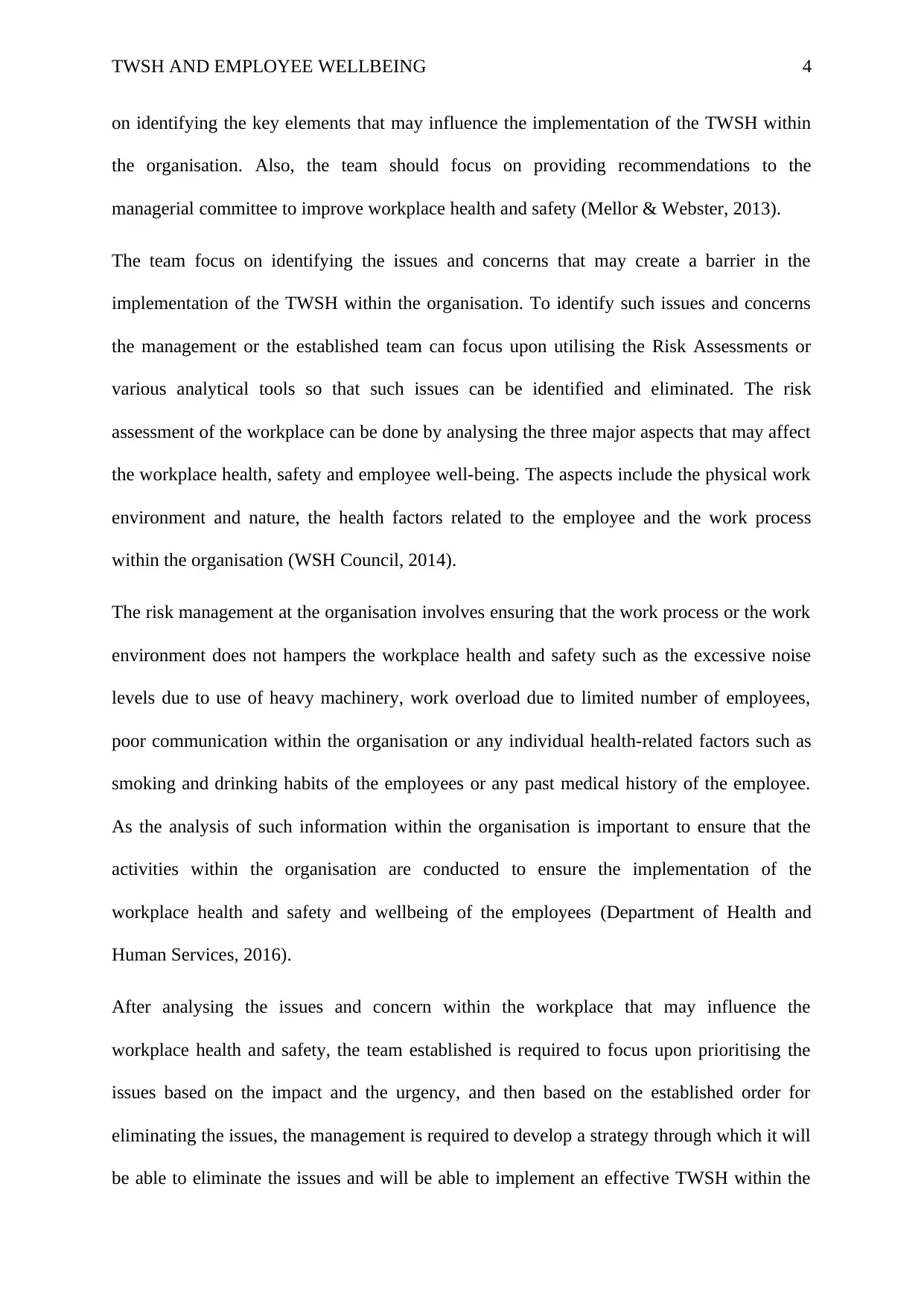
TWSH AND EMPLOYEE WELLBEING 4
on identifying the key elements that may influence the implementation of the TWSH within
the organisation. Also, the team should focus on providing recommendations to the
managerial committee to improve workplace health and safety (Mellor & Webster, 2013).
The team focus on identifying the issues and concerns that may create a barrier in the
implementation of the TWSH within the organisation. To identify such issues and concerns
the management or the established team can focus upon utilising the Risk Assessments or
various analytical tools so that such issues can be identified and eliminated. The risk
assessment of the workplace can be done by analysing the three major aspects that may affect
the workplace health, safety and employee well-being. The aspects include the physical work
environment and nature, the health factors related to the employee and the work process
within the organisation (WSH Council, 2014).
The risk management at the organisation involves ensuring that the work process or the work
environment does not hampers the workplace health and safety such as the excessive noise
levels due to use of heavy machinery, work overload due to limited number of employees,
poor communication within the organisation or any individual health-related factors such as
smoking and drinking habits of the employees or any past medical history of the employee.
As the analysis of such information within the organisation is important to ensure that the
activities within the organisation are conducted to ensure the implementation of the
workplace health and safety and wellbeing of the employees (Department of Health and
Human Services, 2016).
After analysing the issues and concern within the workplace that may influence the
workplace health and safety, the team established is required to focus upon prioritising the
issues based on the impact and the urgency, and then based on the established order for
eliminating the issues, the management is required to develop a strategy through which it will
be able to eliminate the issues and will be able to implement an effective TWSH within the
on identifying the key elements that may influence the implementation of the TWSH within
the organisation. Also, the team should focus on providing recommendations to the
managerial committee to improve workplace health and safety (Mellor & Webster, 2013).
The team focus on identifying the issues and concerns that may create a barrier in the
implementation of the TWSH within the organisation. To identify such issues and concerns
the management or the established team can focus upon utilising the Risk Assessments or
various analytical tools so that such issues can be identified and eliminated. The risk
assessment of the workplace can be done by analysing the three major aspects that may affect
the workplace health, safety and employee well-being. The aspects include the physical work
environment and nature, the health factors related to the employee and the work process
within the organisation (WSH Council, 2014).
The risk management at the organisation involves ensuring that the work process or the work
environment does not hampers the workplace health and safety such as the excessive noise
levels due to use of heavy machinery, work overload due to limited number of employees,
poor communication within the organisation or any individual health-related factors such as
smoking and drinking habits of the employees or any past medical history of the employee.
As the analysis of such information within the organisation is important to ensure that the
activities within the organisation are conducted to ensure the implementation of the
workplace health and safety and wellbeing of the employees (Department of Health and
Human Services, 2016).
After analysing the issues and concern within the workplace that may influence the
workplace health and safety, the team established is required to focus upon prioritising the
issues based on the impact and the urgency, and then based on the established order for
eliminating the issues, the management is required to develop a strategy through which it will
be able to eliminate the issues and will be able to implement an effective TWSH within the
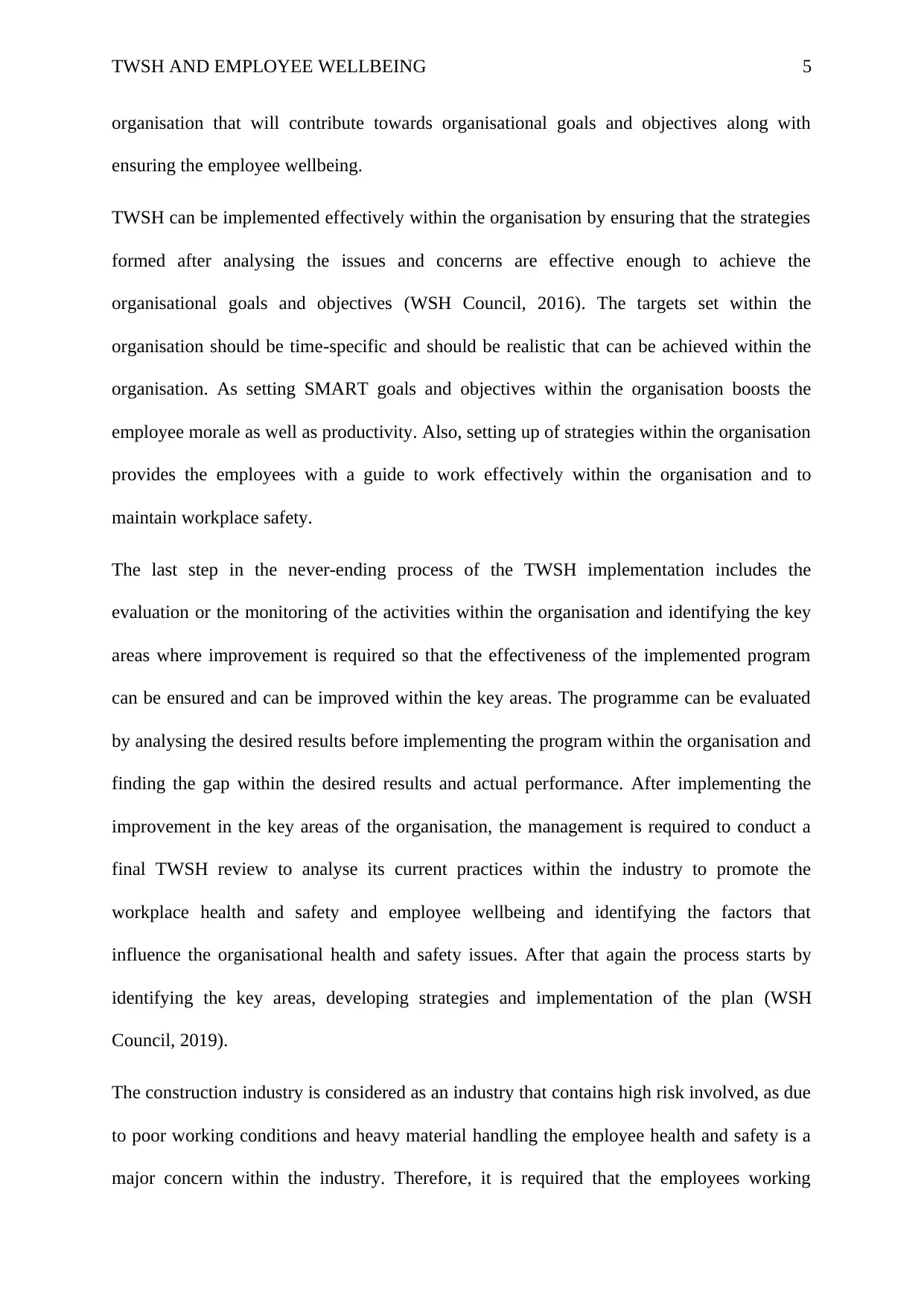
TWSH AND EMPLOYEE WELLBEING 5
organisation that will contribute towards organisational goals and objectives along with
ensuring the employee wellbeing.
TWSH can be implemented effectively within the organisation by ensuring that the strategies
formed after analysing the issues and concerns are effective enough to achieve the
organisational goals and objectives (WSH Council, 2016). The targets set within the
organisation should be time-specific and should be realistic that can be achieved within the
organisation. As setting SMART goals and objectives within the organisation boosts the
employee morale as well as productivity. Also, setting up of strategies within the organisation
provides the employees with a guide to work effectively within the organisation and to
maintain workplace safety.
The last step in the never-ending process of the TWSH implementation includes the
evaluation or the monitoring of the activities within the organisation and identifying the key
areas where improvement is required so that the effectiveness of the implemented program
can be ensured and can be improved within the key areas. The programme can be evaluated
by analysing the desired results before implementing the program within the organisation and
finding the gap within the desired results and actual performance. After implementing the
improvement in the key areas of the organisation, the management is required to conduct a
final TWSH review to analyse its current practices within the industry to promote the
workplace health and safety and employee wellbeing and identifying the factors that
influence the organisational health and safety issues. After that again the process starts by
identifying the key areas, developing strategies and implementation of the plan (WSH
Council, 2019).
The construction industry is considered as an industry that contains high risk involved, as due
to poor working conditions and heavy material handling the employee health and safety is a
major concern within the industry. Therefore, it is required that the employees working
organisation that will contribute towards organisational goals and objectives along with
ensuring the employee wellbeing.
TWSH can be implemented effectively within the organisation by ensuring that the strategies
formed after analysing the issues and concerns are effective enough to achieve the
organisational goals and objectives (WSH Council, 2016). The targets set within the
organisation should be time-specific and should be realistic that can be achieved within the
organisation. As setting SMART goals and objectives within the organisation boosts the
employee morale as well as productivity. Also, setting up of strategies within the organisation
provides the employees with a guide to work effectively within the organisation and to
maintain workplace safety.
The last step in the never-ending process of the TWSH implementation includes the
evaluation or the monitoring of the activities within the organisation and identifying the key
areas where improvement is required so that the effectiveness of the implemented program
can be ensured and can be improved within the key areas. The programme can be evaluated
by analysing the desired results before implementing the program within the organisation and
finding the gap within the desired results and actual performance. After implementing the
improvement in the key areas of the organisation, the management is required to conduct a
final TWSH review to analyse its current practices within the industry to promote the
workplace health and safety and employee wellbeing and identifying the factors that
influence the organisational health and safety issues. After that again the process starts by
identifying the key areas, developing strategies and implementation of the plan (WSH
Council, 2019).
The construction industry is considered as an industry that contains high risk involved, as due
to poor working conditions and heavy material handling the employee health and safety is a
major concern within the industry. Therefore, it is required that the employees working
⊘ This is a preview!⊘
Do you want full access?
Subscribe today to unlock all pages.

Trusted by 1+ million students worldwide
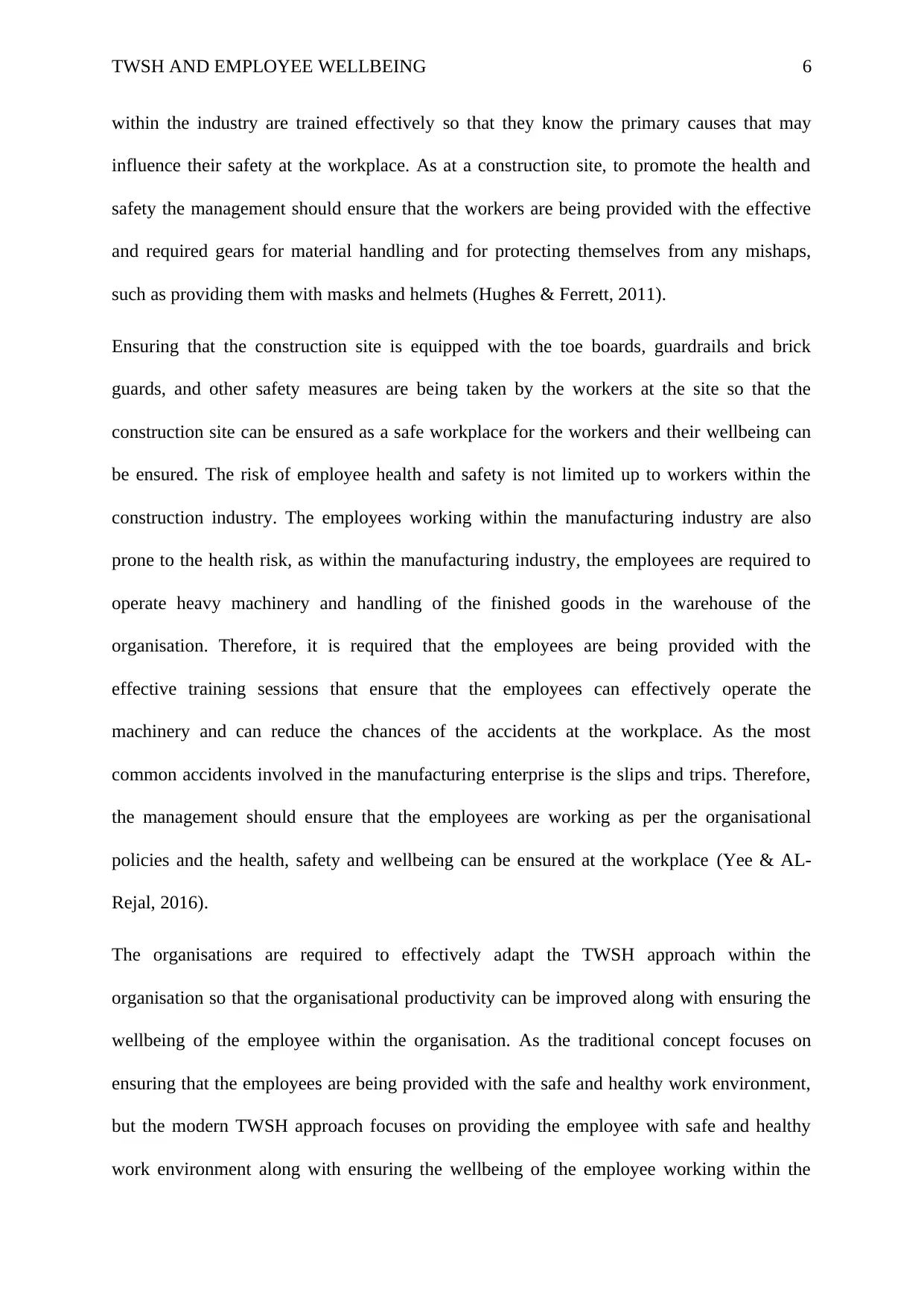
TWSH AND EMPLOYEE WELLBEING 6
within the industry are trained effectively so that they know the primary causes that may
influence their safety at the workplace. As at a construction site, to promote the health and
safety the management should ensure that the workers are being provided with the effective
and required gears for material handling and for protecting themselves from any mishaps,
such as providing them with masks and helmets (Hughes & Ferrett, 2011).
Ensuring that the construction site is equipped with the toe boards, guardrails and brick
guards, and other safety measures are being taken by the workers at the site so that the
construction site can be ensured as a safe workplace for the workers and their wellbeing can
be ensured. The risk of employee health and safety is not limited up to workers within the
construction industry. The employees working within the manufacturing industry are also
prone to the health risk, as within the manufacturing industry, the employees are required to
operate heavy machinery and handling of the finished goods in the warehouse of the
organisation. Therefore, it is required that the employees are being provided with the
effective training sessions that ensure that the employees can effectively operate the
machinery and can reduce the chances of the accidents at the workplace. As the most
common accidents involved in the manufacturing enterprise is the slips and trips. Therefore,
the management should ensure that the employees are working as per the organisational
policies and the health, safety and wellbeing can be ensured at the workplace (Yee & AL-
Rejal, 2016).
The organisations are required to effectively adapt the TWSH approach within the
organisation so that the organisational productivity can be improved along with ensuring the
wellbeing of the employee within the organisation. As the traditional concept focuses on
ensuring that the employees are being provided with the safe and healthy work environment,
but the modern TWSH approach focuses on providing the employee with safe and healthy
work environment along with ensuring the wellbeing of the employee working within the
within the industry are trained effectively so that they know the primary causes that may
influence their safety at the workplace. As at a construction site, to promote the health and
safety the management should ensure that the workers are being provided with the effective
and required gears for material handling and for protecting themselves from any mishaps,
such as providing them with masks and helmets (Hughes & Ferrett, 2011).
Ensuring that the construction site is equipped with the toe boards, guardrails and brick
guards, and other safety measures are being taken by the workers at the site so that the
construction site can be ensured as a safe workplace for the workers and their wellbeing can
be ensured. The risk of employee health and safety is not limited up to workers within the
construction industry. The employees working within the manufacturing industry are also
prone to the health risk, as within the manufacturing industry, the employees are required to
operate heavy machinery and handling of the finished goods in the warehouse of the
organisation. Therefore, it is required that the employees are being provided with the
effective training sessions that ensure that the employees can effectively operate the
machinery and can reduce the chances of the accidents at the workplace. As the most
common accidents involved in the manufacturing enterprise is the slips and trips. Therefore,
the management should ensure that the employees are working as per the organisational
policies and the health, safety and wellbeing can be ensured at the workplace (Yee & AL-
Rejal, 2016).
The organisations are required to effectively adapt the TWSH approach within the
organisation so that the organisational productivity can be improved along with ensuring the
wellbeing of the employee within the organisation. As the traditional concept focuses on
ensuring that the employees are being provided with the safe and healthy work environment,
but the modern TWSH approach focuses on providing the employee with safe and healthy
work environment along with ensuring the wellbeing of the employee working within the
Paraphrase This Document
Need a fresh take? Get an instant paraphrase of this document with our AI Paraphraser
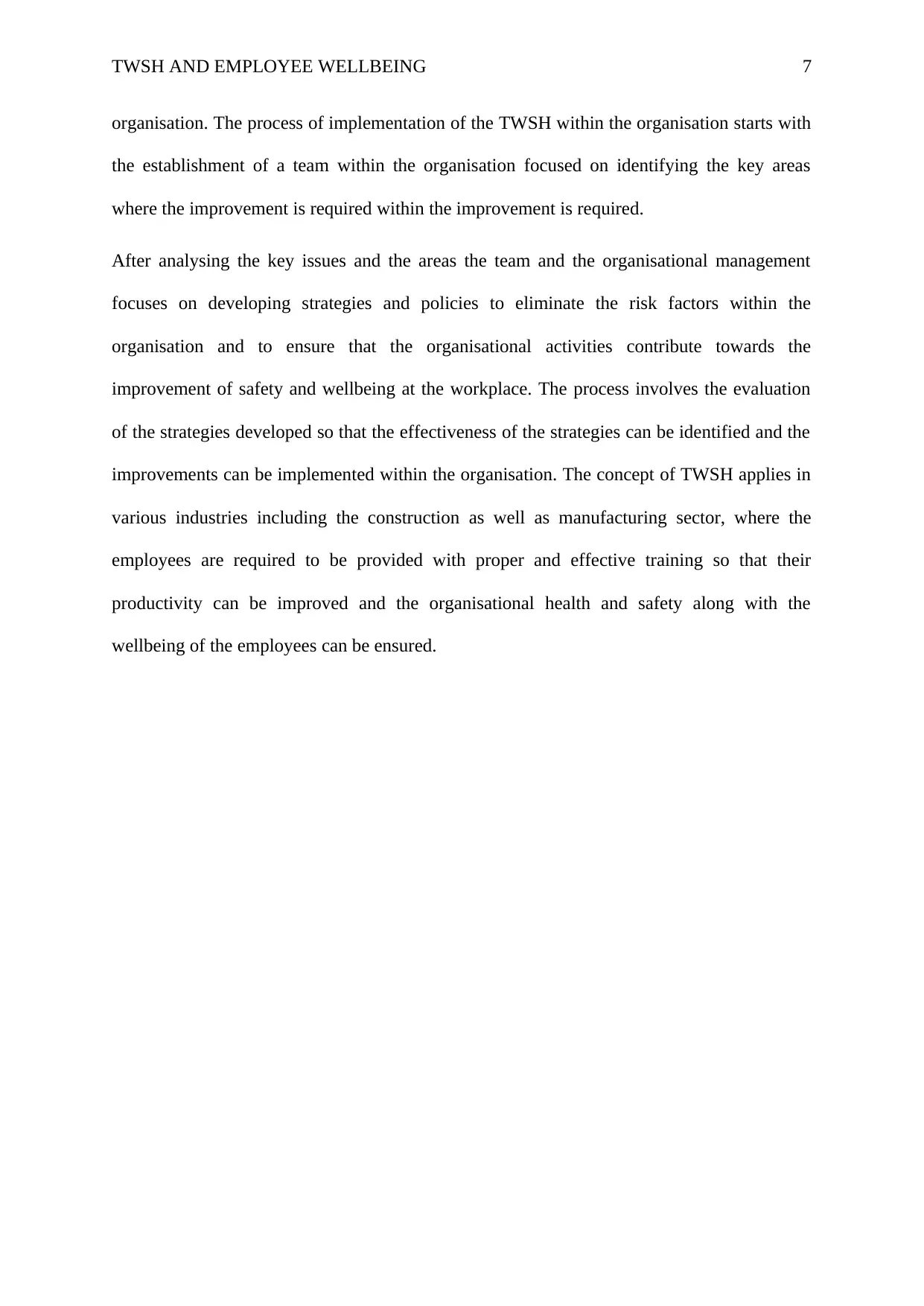
TWSH AND EMPLOYEE WELLBEING 7
organisation. The process of implementation of the TWSH within the organisation starts with
the establishment of a team within the organisation focused on identifying the key areas
where the improvement is required within the improvement is required.
After analysing the key issues and the areas the team and the organisational management
focuses on developing strategies and policies to eliminate the risk factors within the
organisation and to ensure that the organisational activities contribute towards the
improvement of safety and wellbeing at the workplace. The process involves the evaluation
of the strategies developed so that the effectiveness of the strategies can be identified and the
improvements can be implemented within the organisation. The concept of TWSH applies in
various industries including the construction as well as manufacturing sector, where the
employees are required to be provided with proper and effective training so that their
productivity can be improved and the organisational health and safety along with the
wellbeing of the employees can be ensured.
organisation. The process of implementation of the TWSH within the organisation starts with
the establishment of a team within the organisation focused on identifying the key areas
where the improvement is required within the improvement is required.
After analysing the key issues and the areas the team and the organisational management
focuses on developing strategies and policies to eliminate the risk factors within the
organisation and to ensure that the organisational activities contribute towards the
improvement of safety and wellbeing at the workplace. The process involves the evaluation
of the strategies developed so that the effectiveness of the strategies can be identified and the
improvements can be implemented within the organisation. The concept of TWSH applies in
various industries including the construction as well as manufacturing sector, where the
employees are required to be provided with proper and effective training so that their
productivity can be improved and the organisational health and safety along with the
wellbeing of the employees can be ensured.
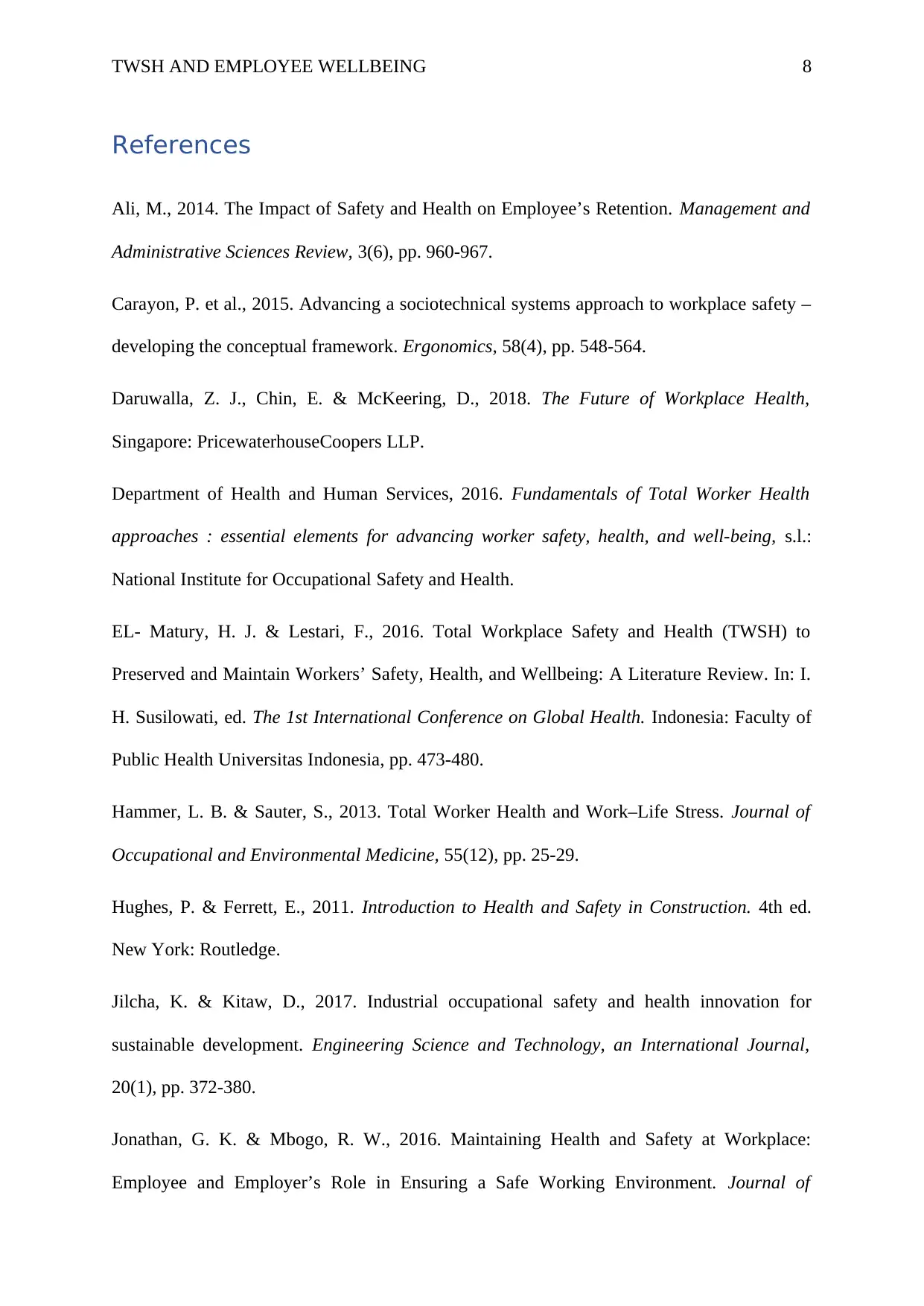
TWSH AND EMPLOYEE WELLBEING 8
References
Ali, M., 2014. The Impact of Safety and Health on Employee’s Retention. Management and
Administrative Sciences Review, 3(6), pp. 960-967.
Carayon, P. et al., 2015. Advancing a sociotechnical systems approach to workplace safety –
developing the conceptual framework. Ergonomics, 58(4), pp. 548-564.
Daruwalla, Z. J., Chin, E. & McKeering, D., 2018. The Future of Workplace Health,
Singapore: PricewaterhouseCoopers LLP.
Department of Health and Human Services, 2016. Fundamentals of Total Worker Health
approaches : essential elements for advancing worker safety, health, and well-being, s.l.:
National Institute for Occupational Safety and Health.
EL- Matury, H. J. & Lestari, F., 2016. Total Workplace Safety and Health (TWSH) to
Preserved and Maintain Workers’ Safety, Health, and Wellbeing: A Literature Review. In: I.
H. Susilowati, ed. The 1st International Conference on Global Health. Indonesia: Faculty of
Public Health Universitas Indonesia, pp. 473-480.
Hammer, L. B. & Sauter, S., 2013. Total Worker Health and Work–Life Stress. Journal of
Occupational and Environmental Medicine, 55(12), pp. 25-29.
Hughes, P. & Ferrett, E., 2011. Introduction to Health and Safety in Construction. 4th ed.
New York: Routledge.
Jilcha, K. & Kitaw, D., 2017. Industrial occupational safety and health innovation for
sustainable development. Engineering Science and Technology, an International Journal,
20(1), pp. 372-380.
Jonathan, G. K. & Mbogo, R. W., 2016. Maintaining Health and Safety at Workplace:
Employee and Employer’s Role in Ensuring a Safe Working Environment. Journal of
References
Ali, M., 2014. The Impact of Safety and Health on Employee’s Retention. Management and
Administrative Sciences Review, 3(6), pp. 960-967.
Carayon, P. et al., 2015. Advancing a sociotechnical systems approach to workplace safety –
developing the conceptual framework. Ergonomics, 58(4), pp. 548-564.
Daruwalla, Z. J., Chin, E. & McKeering, D., 2018. The Future of Workplace Health,
Singapore: PricewaterhouseCoopers LLP.
Department of Health and Human Services, 2016. Fundamentals of Total Worker Health
approaches : essential elements for advancing worker safety, health, and well-being, s.l.:
National Institute for Occupational Safety and Health.
EL- Matury, H. J. & Lestari, F., 2016. Total Workplace Safety and Health (TWSH) to
Preserved and Maintain Workers’ Safety, Health, and Wellbeing: A Literature Review. In: I.
H. Susilowati, ed. The 1st International Conference on Global Health. Indonesia: Faculty of
Public Health Universitas Indonesia, pp. 473-480.
Hammer, L. B. & Sauter, S., 2013. Total Worker Health and Work–Life Stress. Journal of
Occupational and Environmental Medicine, 55(12), pp. 25-29.
Hughes, P. & Ferrett, E., 2011. Introduction to Health and Safety in Construction. 4th ed.
New York: Routledge.
Jilcha, K. & Kitaw, D., 2017. Industrial occupational safety and health innovation for
sustainable development. Engineering Science and Technology, an International Journal,
20(1), pp. 372-380.
Jonathan, G. K. & Mbogo, R. W., 2016. Maintaining Health and Safety at Workplace:
Employee and Employer’s Role in Ensuring a Safe Working Environment. Journal of
⊘ This is a preview!⊘
Do you want full access?
Subscribe today to unlock all pages.

Trusted by 1+ million students worldwide
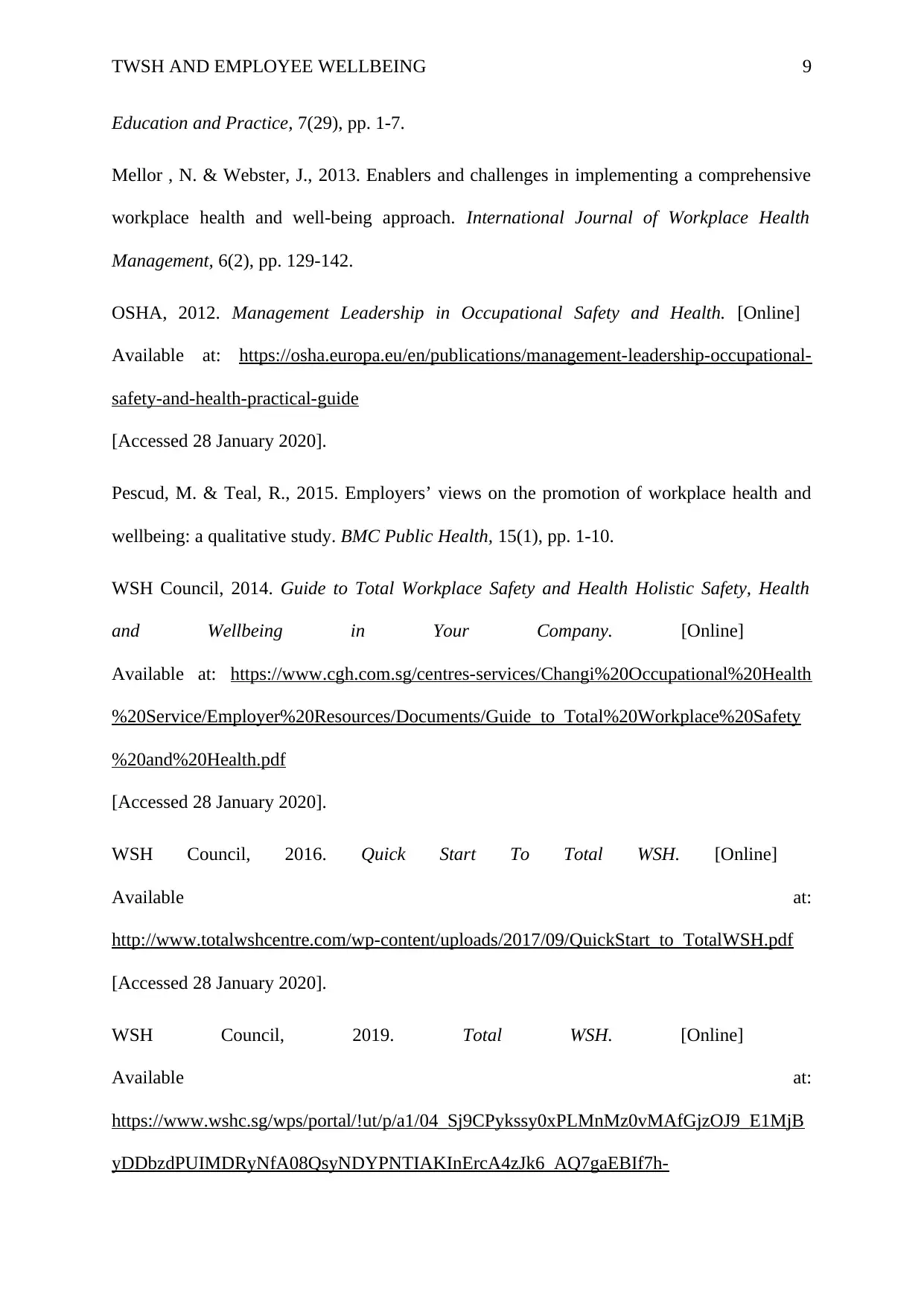
TWSH AND EMPLOYEE WELLBEING 9
Education and Practice, 7(29), pp. 1-7.
Mellor , N. & Webster, J., 2013. Enablers and challenges in implementing a comprehensive
workplace health and well‐being approach. International Journal of Workplace Health
Management, 6(2), pp. 129-142.
OSHA, 2012. Management Leadership in Occupational Safety and Health. [Online]
Available at: https://osha.europa.eu/en/publications/management-leadership-occupational-
safety-and-health-practical-guide
[Accessed 28 January 2020].
Pescud, M. & Teal, R., 2015. Employers’ views on the promotion of workplace health and
wellbeing: a qualitative study. BMC Public Health, 15(1), pp. 1-10.
WSH Council, 2014. Guide to Total Workplace Safety and Health Holistic Safety, Health
and Wellbeing in Your Company. [Online]
Available at: https://www.cgh.com.sg/centres-services/Changi%20Occupational%20Health
%20Service/Employer%20Resources/Documents/Guide_to_Total%20Workplace%20Safety
%20and%20Health.pdf
[Accessed 28 January 2020].
WSH Council, 2016. Quick Start To Total WSH. [Online]
Available at:
http://www.totalwshcentre.com/wp-content/uploads/2017/09/QuickStart_to_TotalWSH.pdf
[Accessed 28 January 2020].
WSH Council, 2019. Total WSH. [Online]
Available at:
https://www.wshc.sg/wps/portal/!ut/p/a1/04_Sj9CPykssy0xPLMnMz0vMAfGjzOJ9_E1MjB
yDDbzdPUIMDRyNfA08QsyNDYPNTIAKInErcA4zJk6_AQ7gaEBIf7h-
Education and Practice, 7(29), pp. 1-7.
Mellor , N. & Webster, J., 2013. Enablers and challenges in implementing a comprehensive
workplace health and well‐being approach. International Journal of Workplace Health
Management, 6(2), pp. 129-142.
OSHA, 2012. Management Leadership in Occupational Safety and Health. [Online]
Available at: https://osha.europa.eu/en/publications/management-leadership-occupational-
safety-and-health-practical-guide
[Accessed 28 January 2020].
Pescud, M. & Teal, R., 2015. Employers’ views on the promotion of workplace health and
wellbeing: a qualitative study. BMC Public Health, 15(1), pp. 1-10.
WSH Council, 2014. Guide to Total Workplace Safety and Health Holistic Safety, Health
and Wellbeing in Your Company. [Online]
Available at: https://www.cgh.com.sg/centres-services/Changi%20Occupational%20Health
%20Service/Employer%20Resources/Documents/Guide_to_Total%20Workplace%20Safety
%20and%20Health.pdf
[Accessed 28 January 2020].
WSH Council, 2016. Quick Start To Total WSH. [Online]
Available at:
http://www.totalwshcentre.com/wp-content/uploads/2017/09/QuickStart_to_TotalWSH.pdf
[Accessed 28 January 2020].
WSH Council, 2019. Total WSH. [Online]
Available at:
https://www.wshc.sg/wps/portal/!ut/p/a1/04_Sj9CPykssy0xPLMnMz0vMAfGjzOJ9_E1MjB
yDDbzdPUIMDRyNfA08QsyNDYPNTIAKInErcA4zJk6_AQ7gaEBIf7h-
Paraphrase This Document
Need a fresh take? Get an instant paraphrase of this document with our AI Paraphraser
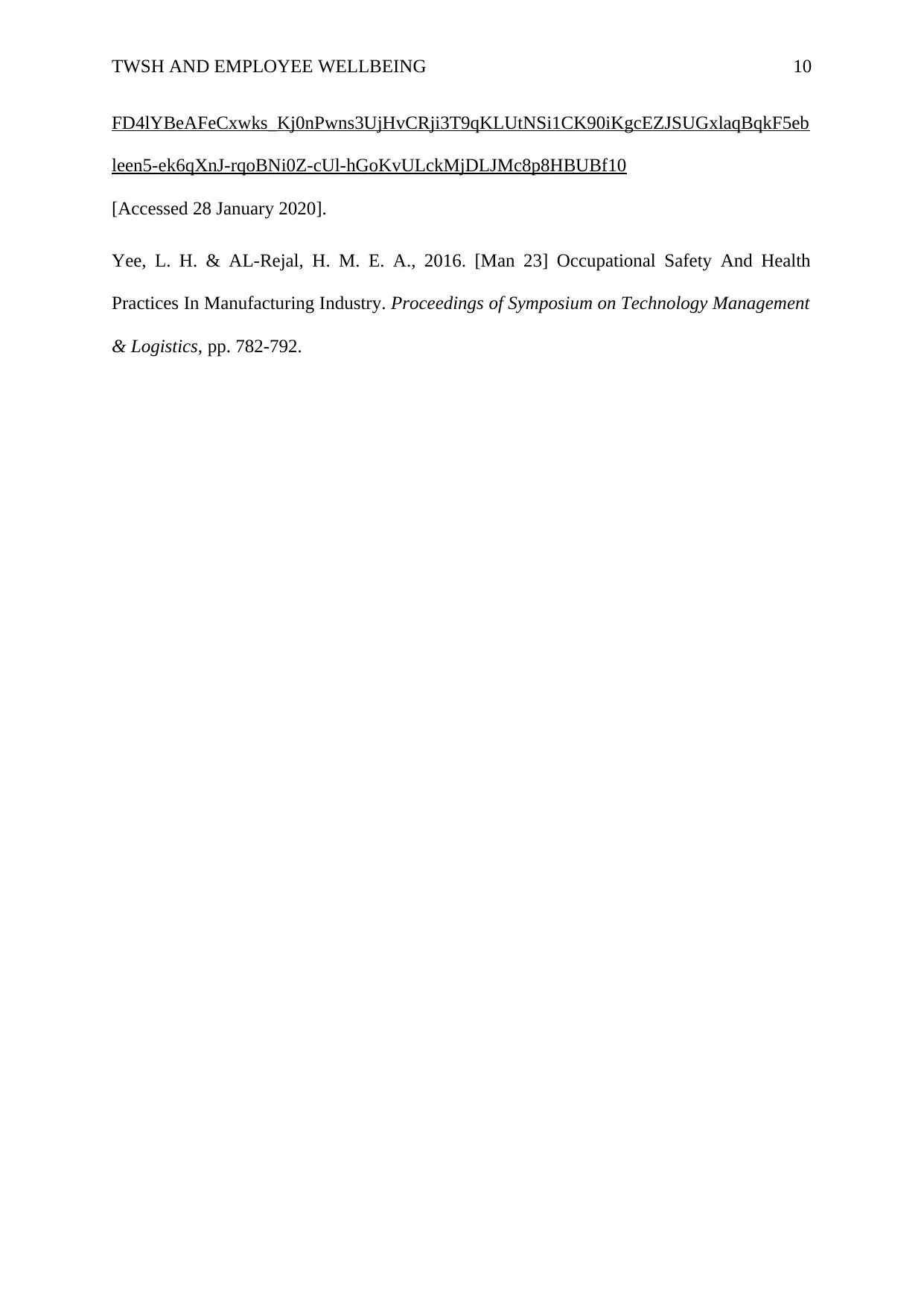
TWSH AND EMPLOYEE WELLBEING 10
FD4lYBeAFeCxwks_Kj0nPwns3UjHvCRji3T9qKLUtNSi1CK90iKgcEZJSUGxlaqBqkF5eb
leen5-ek6qXnJ-rqoBNi0Z-cUl-hGoKvULckMjDLJMc8p8HBUBf10
[Accessed 28 January 2020].
Yee, L. H. & AL-Rejal, H. M. E. A., 2016. [Man 23] Occupational Safety And Health
Practices In Manufacturing Industry. Proceedings of Symposium on Technology Management
& Logistics, pp. 782-792.
FD4lYBeAFeCxwks_Kj0nPwns3UjHvCRji3T9qKLUtNSi1CK90iKgcEZJSUGxlaqBqkF5eb
leen5-ek6qXnJ-rqoBNi0Z-cUl-hGoKvULckMjDLJMc8p8HBUBf10
[Accessed 28 January 2020].
Yee, L. H. & AL-Rejal, H. M. E. A., 2016. [Man 23] Occupational Safety And Health
Practices In Manufacturing Industry. Proceedings of Symposium on Technology Management
& Logistics, pp. 782-792.
1 out of 11
Related Documents
Your All-in-One AI-Powered Toolkit for Academic Success.
+13062052269
info@desklib.com
Available 24*7 on WhatsApp / Email
![[object Object]](/_next/static/media/star-bottom.7253800d.svg)
Unlock your academic potential
Copyright © 2020–2025 A2Z Services. All Rights Reserved. Developed and managed by ZUCOL.





